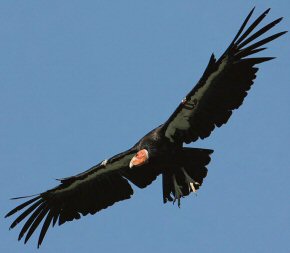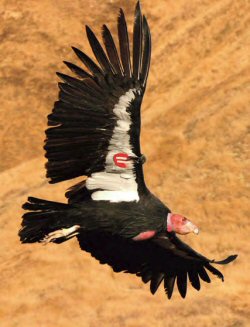SEJournal Online is the digital news magazine of the Society of Environmental Journalists. Learn more about SEJournal Online, including submission, subscription and advertising information.
Feature
|
|
|
California condor. |
By JOHN R. PLATT
It has been called the most successful piece of environmental legislation ever, but at times it has also been one of the most controversial. Over the past 40 years the Endangered Species Act has helped to bring several threatened species — including the iconic bald eagle — back from the brink and to stabilize the declining populations of the majority of the other species that it protects. But despite its sucesses, the ESA in many ways remains both poorly understood and under threat from political forces that seek to undermine or dismantle it. As we head toward 40th anniversary of the Endangered Species Act in December, here are 40 things that environmental journalists should know about the Act and how they can cover it. This is hardly comprehensive, but it may help to illuminate some of the issues in question as the Act prepares for its second 40 years.
The basics
1. President Richard M. Nixon signed the Endangered Species Act, or ESA, into law on December 28, 1973, although it was not actually the first U.S. law protecting threatened species. The Lacey Act of 1900, which is still on the books, placed the first limitations on interstate transport in threatened plant and animal species. The Migratory Bird Treaty Act of 1918 and the Marine Mammal Protection Act of 1972 — both of which are also still in effect — offered safeguards for certain species in the air and ocean. The Endangered Species Protection Act of 1966 offered some protection for 76 charismatic species, although it only protected vertebrates and could only do so by acquiring key habitats. The ESA replaced that law and added the ability to protect all species and ecosystems through a variety of mechanisms.
2.The primary responsibility of conserving species on the ESA falls to the U.S. Fish and Wildlife Service, or FWS, for terrestrial and freshwater species. The National Marine Fisheries Service, or NMFS, handles protections for marine species and some fish that migrate into fresh water. FWS falls under the aegis of the Department of the Interior while NMFS is division of the National Oceanic Atmospheric Administration (which itself is an agency of the Department of Commerce).
3. In addition to the ESA,many other laws serve to protect rare species. “There are a number of federal environmental and land-use laws that have conservation as part of their objective,” says Gary Frazer, assistant director for endangered species at FWS, who calls the ESA a “safety net” for when these other mechanisms are not effective. The United States is also a signatory to the 1975 Convention on International Trade in Endangered Species of Wild Fauna Flora, or CITES, which controls or bans cross-boundary traffic of threatened species. This year Lebanon became the 178th nation to join CITES.
4. States, too, often have their own endangered species lists, which may or may not contain the same species as the federal list.
How the ESA works
5. Species are selected to be protected under the ESA based on their taxonomic uniqueness, as well as the imminence and magnitude of the threats they face. Threats can include habitat loss or destruction, overharvesting, disease or predation, inadequacies of other protections, and other manmade factors that affect a species’ existence.
6. The ESA has two categories: Endangered species, which are in danger of extinction either as a species or in a significant portion of its habitat, and threatened species, which are likely to become endangered based on current threats.
7. The ESA protects species by prohibiting individuals or organizations from “taking” a listed species. “Take” has a fairly broad definition: “to harass, harm, pursue, hunt, shoot, wound, kill, trap, capture, or collect or attempt to engage in any such action.” Habitat modifications that would impact breeding, feeding or shelter are also included in the definition of “take.”
8. Plants have a different definition of “take.” People can collect or harm endangered plants unless they are located on federal land.
9. Federal agencies must consider the impact on listed species any time they authorize, fund or carry out activities that could impact the species. FWS or NMFS usually recommend “reasonable and prudent alternatives” to lessen the chances that these activities will jeopardize a listed species.
10. FWS and NMFS write detailed recovery plans for most species protected under the ESA. These plans cover biological protocols, necessary research and any management actions that would help bring a species to recovery. These documents are not action plans, but they are used to determine the need for funding and other ongoing activities.
11. The process for getting a species listed involves many steps and usually takes at least a few years. This rulemaking or regulatory process (the same used in other areas of the government) starts with an initial petition, often filed by citizens or environmental groups, followed in 90 days by a response that a species may or may not have “substantial” need for protection. If it moves forward, the next stop involves a status review, followed in 12 months by a finding that protection is warranted, not warranted, or warranted but precluded by other priorities. If the 12-month finding declares protection may be warranted, another year-long process begins. Steps here include publishing a proposed rule, a 60-day public comment period, public hearings if necessary, and finally, if approved, finalization of the new rule to protect a species.
12. Each species protected under the ESA must be reevaluated at least every five years. These five-year reviews use the best available science to determine if a species should maintain its current protected classification, be changed from threatened to endangered (or vice versa), or delisted.
13. The ESA does not regulate private ownership of endangered species, although it does regulate their transport. This means citizens can, depending on state laws, own many animals such as tigers, chimpanzees and other “exotic” pets (case in point: the tragedy in Zanesville, Ohio, where 56 animals were killed after being released from a private reserve). They cannot, however, legally transport these animals across state lines without a permit. The nonprofit Born Free USA maintains a list of state exotic animal laws here.
14. Some endangered species, such as the Mexican gray wolf, can be reintroduced to a former range and live in what is known as experimental populations which can either be classified as essential or non-essential to the survival of the species. A non-essential classification is often used in controversial cases like that of the wolf, since it means in effect that the species doesn’t receive the full protection of the law, allowing wildlife managers greater flexibility to remove animals if they conflict with humans or livestock.
15. What constitutes success under the ESA? “We view success as preventing a species from going extinct, to keep them from sliding further” says FWS’s Frazer, who equates the job to that of an emergency room doctor stabilizing a patient. “That’s our primary focus and I think we’ve been very successful at that. Very few species have gone extinct when we still had a population to manage once they were listed.”
16. The biggest successes come not just from one government agency but from a broad series of partnerships. “It’s far beyond the Fish and Wildlife Service,” says Frazer. “Private landowners, local and state governments, other federal agencies — all of those parties have a role in how habitats and species populations are managed and restored.” He credits almost all major success stories under the ESA to this collaboration toward conservation.
The Endangered Species Act by the numbers
17. As of June 1, a total of 2,095 species were protected under the ESA. Updated counts are always available here.
18. Another 205 species are listed as “candidates” for ESA listing. For FWS, this means the agency has enough information to determine that a species could be proposed for ESA protection but other species have a higher priority. Under the NMFS definition, species require additional information before they can be formally proposed for ESA listing.
19. These numbers do contain overlaps. Species may have multiple recovery plans based on different sub-populations and can be counted more than once as a result. For example, the Steller sea lion is listed as threatened in its eastern distinct population and endangered in its western distinct population.
20. Only 26 species added to the ESA have ever recovered enough to be removed (“delisted”) from the act’s protections. Critics say this is evidence that the ESA does not work, but in reality bringing a nearly extinct species back to healthy population levels takes decades, if it is even possible. You can find reports on all delisted species here.
21. Only 10 U.S.-based species that have been protected under the ESA have gone extinct over the past 40 years. Most of these may have actually been extinct at the time they were first listed under the ESA. The Caribbean monk seal, for example, was last confirmed seen in 1952. It was listed as an endangered species in 1979 while scientists kept looking for evidence that it still existed. It was finally declared extinct in 2008.
22. Several additional species have been delisted because their original taxonomy has been reevaluated or new scientific data has come to light that suggested the original listing was not warranted.
|
|
|
A California condor outfitted with tracking tags flies over the Bitter Creek National Wildlife Refuge in California’s Kern County. Purchased in 1985 to protect the birds’ dwindling habitat, the 14,000-acre refuge is where the last wild female condor was captured by the U.S. Fish & Wildlife Service in 1986 in an unprecedented effort to save the species by taking its last twenty-two survivors into captivity. Numbers have since increased. Photo: U.S. Fish & Wildlife Service. |
23. Species that do not live within the United States can be, and frequently are, protected under the act. The ESA protects 619 international species by banning or limiting their import and trade in their body parts. Rhinos, elephants and tigers are among the species protected in this manner.
How much does the ESA cost?
24. Expenses related to the ESA totaled $1,590,513,332 for fiscal year 2011, the most recent year for which numbers are available. This includes expenditures by all federal agencies as well as $58,446,266 paid by states. Full expenditures broken down by year and species are available here.
25. Chinook salmon received the highest level of ESA funding: nearly $270 million.
26. ESA expenditures of over $1 million each went to 144 species. And 566 species had ESA expenditures of under $50,000 each, while five species had expenditures of just $100 each. Hundreds of species did not receive any ESA funding in fiscal year 2011.
27. A plan to protect a species under the ESA often includes a designation of “critical habitat,” indicating that certain geographic areas contain the features necessary to the survival of that species. The most misunderstood aspect of the ESA, critical habitat designations only affect actions by federal agencies or actions that the federal government funds or permits on those habitats. A critical habitat designation “doesn’t mean that every acre is inviolate,” says Frazer, although it is often perceived as such. “If the basic ability of that habitat to support eating or reproduction or basic ecological functions is compromised, that’s when the act creates a break in those activities.” Although privately held land can be designated as critical habitat, that designation does not impose responsibilities or otherwise affect private landowners or their property rights.
28. Many foes characterize the ESA as being in opposition to economic activities (“lizards vs. oil jobs”). On the other side of the aisle, animal activists sometimes complain the government doesn’t go far enough to protect endangered species (“condors vs. wind power”). But Frazer says, “ a conservation plan that serves to protect a species is also a conservation plan that provides for the reconciliation of the species’ conservation needs and economic development needs.” He says it is “almost never a ‘this or that’” decision, “it’s finding a path forward for both objectives to be obtained,” even if it requires some changes in behavior to minimize the risks to a threatened species.
29. Lawsuits have driven a lot of ESA activity over the years, creating both results and controversy. The law allows any citizen or organization who thinks the government is not fulfilling its responsibilities to file a lawsuit. Frazer acknowledges that sometimes the volume of lawsuits “overwhelms our capacity so that we are not able to do work that is meaningful for conservation,” although he maintains that “has not generally been the case.”
30. These lawsuits did result in FWS settling with the Center for Biological Diversity and other organizations in 2011. Under the settlement, FWS agreed to review 757 species by 2018 to decide if they need protection. “We found a path forward that is allowing us to once again be centered in applying the limited resources we have to the things that have the greatest conservation benefit,” Frazer says. This has often been mischaracterized as a “backdoor deal” by foes of the ESA.
31. The law affects private landowners in one way: they cannot kill or harm a protected species on their properties. A commonly repeated myth, however, states that homeowners could lose their properties under the act. This has never happened, and in fact the FWS provides several ways in which landowners can work with the agency to coexist with any species that live on their properties.
Future of the Endangered Species Act
32. Sen. John Cornyn (R-TX) this year introduced the “Endangered Species Act Settlement Reform Act,” which would give a wide selection of industry groups and local governments the ability to intervene in any future lawsuit settlements. The Center for Biological Diversity calls this “an assault ... on citizen involvement.”
33. Several other lawmakers recently introduced a bill that would make it illegal for environmental groups to receive “economic gain” from filing lawsuits under the ESA, seen by environmentalists as another attack on citizen involvement since some environmental groups have received court costs from FWS following lawsuits.
34. Some states have attempted to assert state rights over the federal ESA. Earlier this year Idaho Gov. Butch Otter signed a bill making it illegal for the federal government to introduce any endangered species into the state without local approval. Critics say the move flies in the face of the nation’s federalist system.
35. Numerous riders attached to other bills have attempted to defund or delay ESA actions, while the most recent U.S. House of Representatives Farm Bill contained language blocking the EPA from taking any action that would protect endangered species from pesticides without prior approval from pesticide manufacturers.
36. House Republicans this year also created a “working group” to consider how the ESA works and “could be updated.” The group is co-chaired by Rep. Doc Hastings (R-WA), who has consistently voted against environmental protections.
Finding story ideas for covering the ESA
37. The FWS maintains communications points of contact for ESA, both on a national level as well as within each of its eight regions. Updated contacts can be found here.
38. Want local stories? You can find which endangered species live in your state here.
39. Want to know more about the science of any species on the ESA? Read the Federal Register filings. They’re usually a great source of information.
40. Talk to the FWS biologists on the ground. They’re fascinating, passionate people often doing remarkable work against great odds.
John R. Platt writes the Extinction Countdown blog for Scientific American. He has written more than 1,300 articles about endangered species. He was recently profiled on SEJ.org’s “Member Spotlight” feature.
Follow on Twitter @johnrplatt
* From the quarterly newsletter SEJournal, Summer 2013. Each new issue of SEJournal is available to members and subscribers only; find subscription information here or learn how to join SEJ. Past issues are archived for the public here.















 Advertisement
Advertisement 



